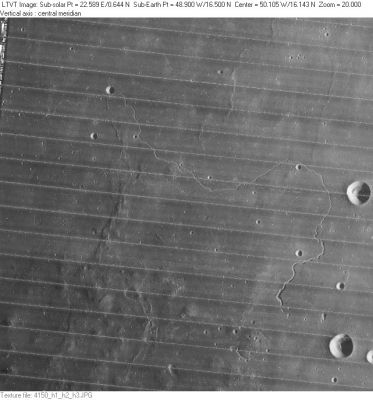Rima Marius
Contents
Rima Marius
|
Lat: 16.36°N, Long: 49.54°W, Length: 283.54 km, Depth: km, [/R%C3%BCkl%2018 Rükl 18] |
Table of Contents

LO-IV-150H The prominent 11-12 km craters on the right are [/Marius Marius] B (top) and [/Marius Marius] C (bottom). Rima Marius winds to their west and north, reaching 4 km [/Marius Marius] P, where it turns a continues a bit farther to the west southwest. The IAU position and diameter quoted above is not large enough to include the part beyond [/Marius Marius] P.
Images
LPOD Photo Gallery Lunar Orbiter Images Apollo Images
Rima Marius was captured on several southward looking oblique Fairchild camera frames made during the mission of Apollo 15. One of these frames is AS15-M-2610 (Hi-Res scan) in which the snaky Rima Marius is seen about halfway between Herodotus (leftward of the frame's centre) and Marius (in the distance, at the curved horizon).
Research Danny Caes
Maps
([/LAC%20zone LAC zone] 39D4) LAC map Geologic map LM map
Description
Elger
([/IAU%20Directions IAU Directions]) MARIUS.-- ... Schmidt in 1862 discovered a long serpentine cleft some distance N. of [/Marius Marius], which has not been seen since.
Wikipedia
Additional Information
- IAU page: Rima Marius
The very erratic looking meandering sinuous rille north of Marius P
- The bowl-shaped crater Marius P is the local "roadsign" to detect the most northern section of Rima Marius. Slightly north of it runs another rille. This sinuous rille is a very difficult one to observe through telescopes, but... very easy to spot on the "Big Shadows" version of the WAC on the LROC-Quickmap! See: http://bit.ly/2iOsGyY . The typical "look" of this kind of sinuous rilles (of both Rima Marius and the unnamed one north of it) is very much like the thin meandering "fissures" in a human skull. I wonder if there are much more examples of this sort of erratic meandering appearances in nature (on earth and on other bodies in the solar system). - DannyCaes DannyCaes Oct 29, 2017
Nomenclature
Named for nearby crater ([/Marius Marius]).
Number 45 in Debra Hurwitz's Atlas and Catalog of Sinuous Rilles.
LROC Articles
LPOD Articles
Bibliography
[/Alphabetical%20Index Named Features] -- Prev: [/Marius Marius] -- Next: [/Markov Markov]
This page has been edited 1 times. The last modification was made by - tychocrater tychocrater on Jun 13, 2009 3:24 pm - afx4u3